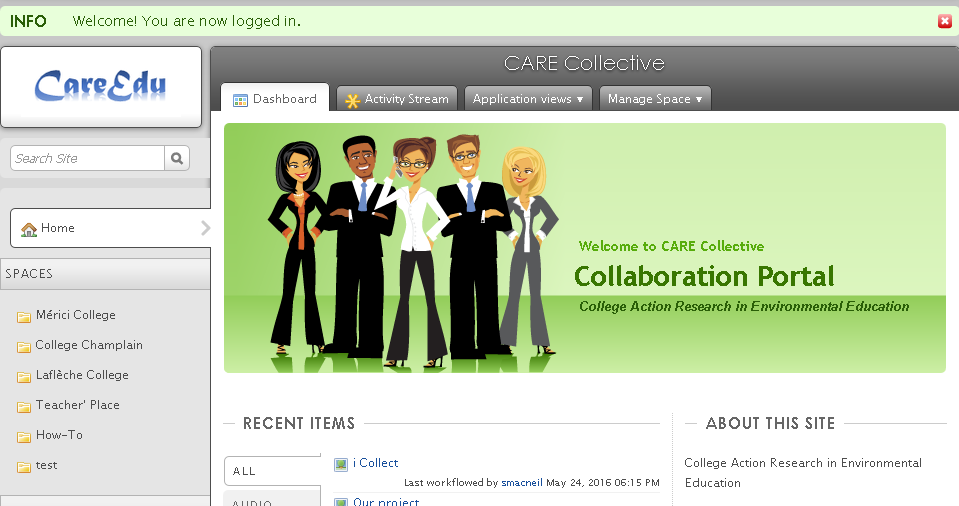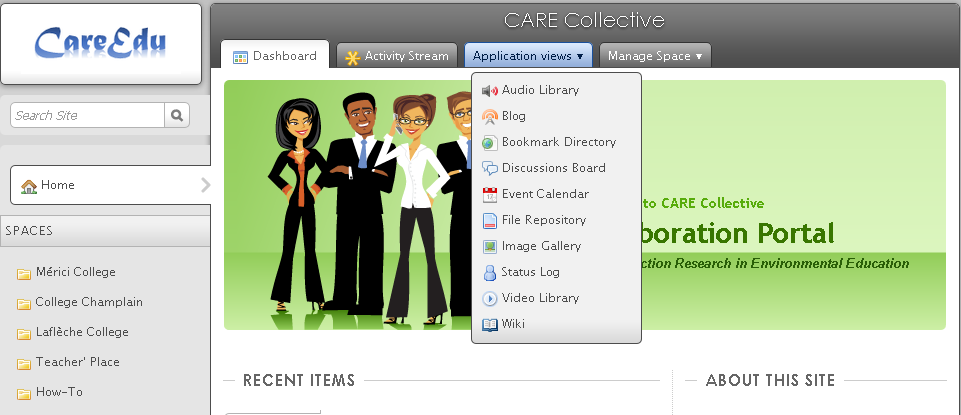Using Action Research to Create an Inter-collegial Student Learning Community
Having collaborated on past endeavours, we were excited about our latest initiative that would bring together students from different colleges, to work together on a common project. With help from an Entente-Canada-Québec (ECQ) grant, we were able to implement our project – Action Research: Learning Communities in Sustainable Development. The main objectives were to engage students in action research, related to sustainable development, and to participate in a learning community using an Internet based platform. The theme of the project made it very accessible, touching courses from various English second language classes, to geography, humanities, social science, science and more!
Although we were the main actors of this project, we were not the only collaborators who made this project a success. In fact, there were 8 teachers, from 3 institutions (Collège Laflèche, Collège Mérici, CEGEP Champlain-St. Lambert) who contributed to this learning community project. We must also mention that Chris Adams, from Dawson College, was our consultant for action research. Several other ESL teachers from both of our colleges jumped on board, increasing the number of students involved in the project to approximately 200. We were extremely pleased to have the participation of Kory Goldberg and Genevieve Aboud from Champlain-St. Lambert, who shared their expertise with us, and joined our learning community with their students from two of their humanities courses: Green Living and Planetary Challenge. They were able to fund projects via a SALTISE grant.
Engaging Students through Action Research and a Learning Community
The project had several objectives, and the main ones, mentioned previously, were reached by sharing the results and final assignments of the action research projects through a learning community. This community allowed for a true exchange of knowledge, and sharing of resources between students from at least 6 different courses and 3 schools.
What is action research, you might wonder? It is similar to a traditional research assignment, however, it goes one step further. Students must not only submit a final paper or give an oral presentation, they must also organise a hands-on activity associated to their topic. For example, in Susan’s class one group researched the topic of how music can help Alzheimer’s patients regain part of their memory. The action portion of their project was to collect donations of old iPods and proceed to give them to the Alzheimer’s Society of Quebec to use in their therapy programs. In Gina’s class, one group researched poverty in their city (Trois-Rivières). They were surprised at the number of families and individuals who were truly in need. This group decided to collect clothing from students, friends and family members in their class and to donate the clothes to a local organisation.
All of the teachers involved now see action research as a means for students to understand that they can make a difference in their communities, in the world and to be grateful for all that they have.
An important goal of this project was to have students share their results and projects in a learning community. This community was created with an online collaboration software called Cyn.in. We created a space for the project called College Action Research in Environmental Education – CareEdu. It was here that students proceeded to upload the information they discovered during their research. This information could then be shared with students from other classes, in other CEGEPs. The software allowed them to comment, ask questions, reply and participate in interesting discussions with each other. They were deepening their own learning through engaging in online discussions and learning about important concerns in other areas of the province.

Examples of the action research topics students worked on and the dialogue that students engage in with the software.
The Online Collaborative Environment
After exploring several different avenues for the online collaboration portion of this project, including Facebook and Google, the IT technician at Mérici suggested we try an online software called Cyn.in. This free online collaboration software comes with many different possibilities, including wikis, blogs, calendars, discussion boards, images, audio, video, etc. It also provides a closed social-media-type-environment so that teachers would not have to worry about wide range public exposure of their students’ comments & assignments. We were fortunate to have received funding in our ECQ grant for the expertise of a technician to help us explore options and get started with the software. The portal for our project, CareEdu, allowed us to create a space for each teacher. Students had access to their own teacher’s space, where they could upload their assignments and resources. This gave teachers the opportunity to control which documents and resources were shared with the community. Teachers reviewed students’ work, provided feedback and students made changes before assignments were made available to the CareEdu community. This allowed for control over the quality of the work and the English language being used. This was especially important as we had a combination of ESL students and English mother-tongue students collaborating in the same space. We didn’t want our ESL students to feel insecure about their work.

The CareEdu dashboard, showing the spaces for each college within the software. Teachers manage their own space for their class, choosing when to make documents visible within the CareEdu community.
Once the documents were ready, and the teacher made them visible within the CareEdu portal, students could then consult the projects and documents of other students from a different class. Through the help of the students, we were also able to create an online resource library for environmental and social issues. All the students involved could add links, videos, or other content in the resource library to share the resources they had used and discovered for their project.

Cyn.in has many different applications within the software, making it easily adaptable to any type of collaboration project.
Of course, the students had no trouble adjusting to the online software and figuring out how to use it. It isn’t a very complicated tool to use. We started working on a guide to help walk teachers through the steps of creating their own space and how to use it with their students, in hopes that we can grow the project in the future.
Future Plans for CareEdu
We have applied for another ECQ grant to continue this project and expand it. Ideally, we would like to open it up to the entire province, getting teachers from all of the CEGEPs and colleges in the province on board. We also see the possibility of expanding the project to enhance English language skills and incorporate peer language learning by having ESL students collaborate with students at English language instruction schools, such as Champlain-St. Lambert. We hope to start it up again in winter 2017 with new classes and hopefully additional teachers from across the province.

